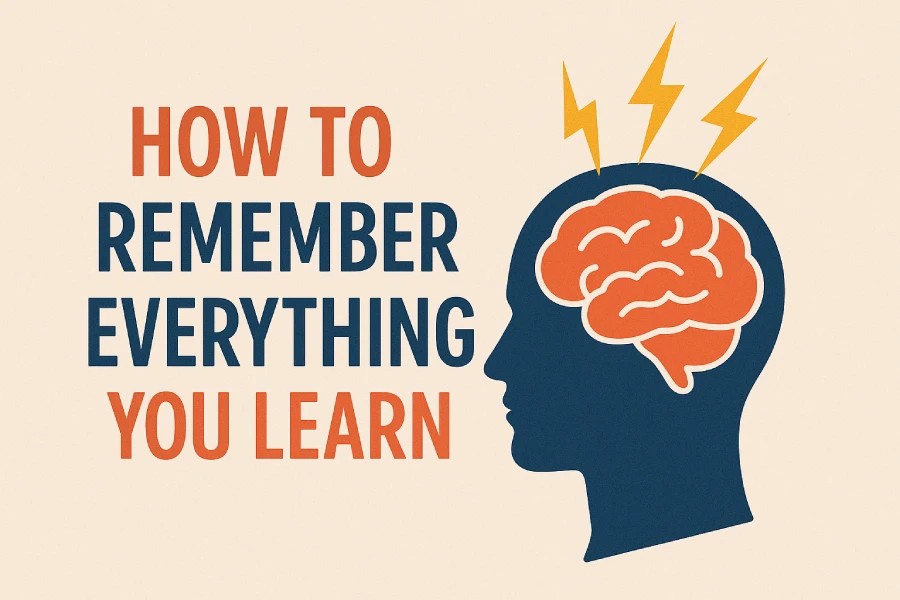How to Remember Everything You Learn: 8 Real Strategies That Actually Work
By Bhupati Barman
March 27, 2025
Update on : March 27, 2025

Let’s be honest—most of us forget things we learn way too quickly. We read a book, take a course, or watch a video, and a few days later… it’s gone. Sound familiar?
The good news is, there are proven ways to remember more of what you learn—without working harder or spending more hours with your nose in a book. It’s all about learning smarter.
Here are 8 practical techniques on how to remember everything you learn that can seriously improve your memory and help you hold onto the knowledge you gain.
Table of Contents
1. Spaced Repetition
Review information at strategic intervals, not all at once.
Instead of cramming everything into one sitting, spaced repetition encourages you to review material over time—at carefully planned intervals. This method works by strengthening your brain’s ability to recall information just before it’s about to be forgotten.
Why it works: Our brains naturally forget over time, but each review session reactivates and strengthens memory.
Research shows: Spaced repetition can improve long-term retention by up to 80%.
Tools to try: Anki, RemNote, or even manual flashcards with spaced review schedules.
2. The Feynman Technique
If you can’t explain it simply, you don’t understand it
This technique involves explaining a concept in your own words—as if you’re teaching it to a 12-year-old. By simplifying and teaching the material, you expose your knowledge gaps and solidify your understanding.
Why it works: Teaching forces you to organize your thoughts and identify what’s missing.
Proven impact: Students using the Feynman Technique score 29% higher on tests on average.
How to do it:
- Choose a concept you’re learning.
- Write down an explanation as if teaching a child.
- Identify any areas where you struggle.
- Go back to the source material to fill in gaps.
- Repeat with a cleaner, simpler version.
3. The 80/20 Rule
Focus on the 20% that gives you 80% of the results
Not all information is created equal. The Pareto Principle suggests that a small portion of your learning material delivers the majority of your understanding.
Why it works: You avoid information overload and focus on what really matters.
Backed by research: Cambridge research shows this leads to 3x better problem-solving transfer.
Tip: Identify the key concepts, formulas, frameworks, or principles that unlock broader understanding—and prioritize those.
4. Learn Through Multiple Senses
Don’t just read—see, hear, and do
Learning through more than one sense helps embed information more deeply in your memory. This is called multi-sensory learning, and it’s particularly effective because the brain has more “pathways” to access the information later.
Why it works: Visual, auditory, and kinesthetic input combine to create a richer memory trace.
Data shows: Information encoded multiple ways shows 65% better recall after 30 days.
How to apply it:
- Watch videos while taking notes
- Say ideas out loud
- Use diagrams or charts
- Teach the concept to someone else
- Write things down while listening to audio
5. Test Yourself Regularly
Quizzing beats rereading every time
Active recall is far more effective than passive review. Instead of rereading notes, try pulling information from memory.
Why it works: Retrieval practice creates stronger neural pathways than passive review.
Improvement rate: Long-term retention increases by up to 80% with regular self-testing.
Ideas to try:
- Use flashcards
- Cover your notes and explain concepts aloud
- Practice with quizzes or mock exams
- Use apps like Quizlet or Anki
6. Mix Up Your Study Topics
Switch topics to keep your brain on its toes
Instead of focusing on just one subject at a time, try alternating between topics that are related. This challenges your brain to make comparisons and connections, which leads to deeper understanding.
Why it works: Interleaving improves your brain’s ability to apply knowledge flexibly.
Results show: Interleaved practice can improve test performance by 43% compared to blocked (one-topic) study.
Example: If you’re learning math, alternate between algebra, geometry, and word problems in one session instead of mastering one fully before switching.
7. Write by Hand, Not Keyboard
The pen is mightier than the keyboard
↳ Handwriting activates more areas in your learning brain.
Why it works: Writing slows you down just enough to process and rephrase what you’re learning.
Proven benefit: Conceptual understanding improves by 24% when you write instead of type.
What to do: Even if you prefer digital tools, use a notebook for key takeaways, summaries, or concept maps. The act of writing cements understanding.
8. Optimize Sleep for Memory
Your brain keeps learning while you rest
Sleep isn’t just for recovery—it’s when your brain consolidates and organizes information. If you’re skipping sleep or pushing through exhaustion, you’re sabotaging your ability to remember.
Why it works: Study difficult material before sleep for better encoding.
Bonus: A 20-minute nap after learning can improve recall by up to 40%.
Smart strategy: Study challenging material before bed. Your brain will process it overnight—so you wake up knowing more than when you fell asleep.
Conclusion
If you’ve ever wished you could remember more of what you learn, now you have a blueprint. These strategies are backed by solid research—and more importantly, they’re practical.
Here’s a quick recap:
- Space out your reviews over time.
- Teach what you learn to someone else.
- Focus on what matters most (the vital 20%).
- Use your eyes, ears, and hands to learn.
- Quiz yourself often, even before you feel “ready.”
- Mix your topics during study sessions.
- Write by hand when it counts.
- Don’t underestimate the power of sleep.
Learning is a lifelong journey—and memory is the fuel that keeps it going. Start applying even two or three of these techniques today, and you’ll notice a real difference in what you retain and how confident you feel.
















